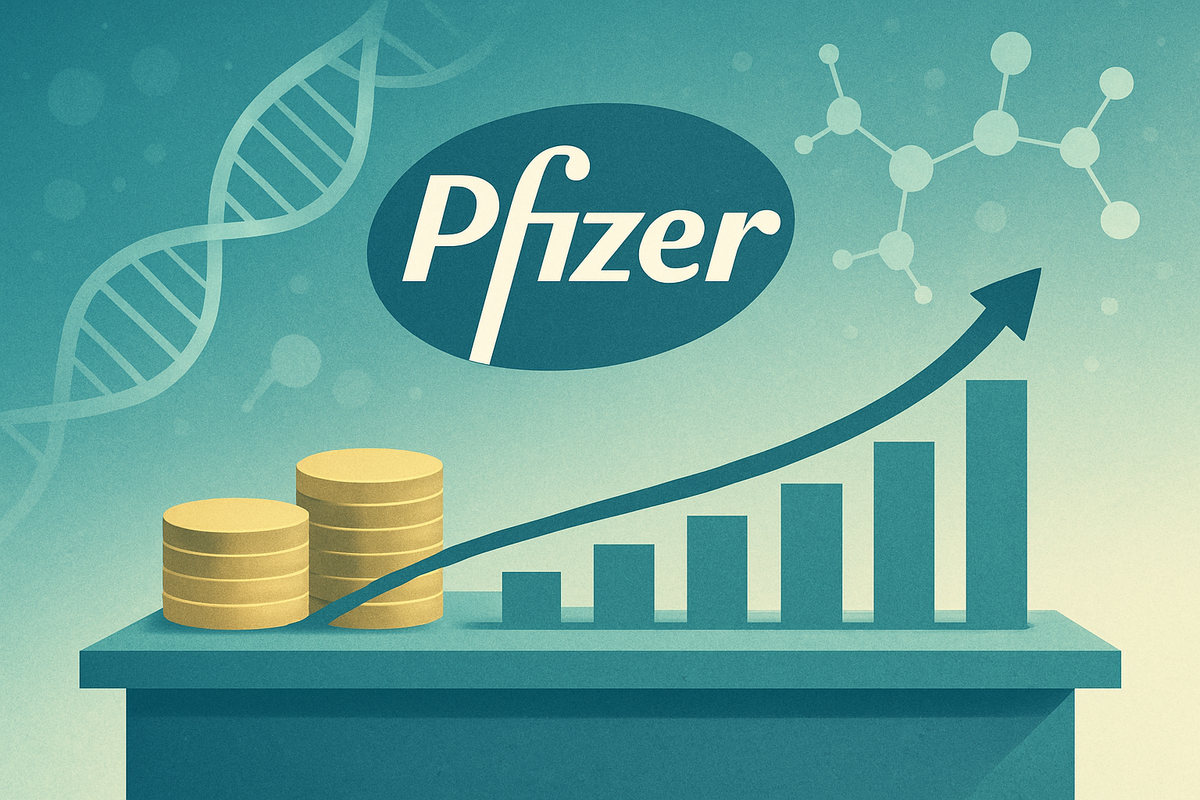
New York, NY – October 9, 2025 – Pfizer Inc. (NYSE: PFE) has once again affirmed its steadfast commitment to shareholder returns, declaring a $0.43 per-share cash dividend for the fourth quarter of 2025. This latest payout marks a significant milestone: the company's 348th consecutive quarterly dividend. The unwavering consistency of this payment underscores Pfizer's enduring financial stability and disciplined capital allocation strategy, offering a predictable income stream to investors during a period of considerable strategic evolution for the pharmaceutical giant.
The declaration comes as Pfizer navigates a complex and dynamic landscape, characterized by the winding down of its highly successful COVID-19 product revenues and the looming challenge of a significant patent cliff. Despite these transformative pressures, the continuous dividend payment signals management's confidence in Pfizer's underlying cash flow generation and its strategic initiatives designed to secure future growth. For shareholders, particularly those focused on income, this consistent dividend reinforces Pfizer's appeal as a reliable investment, maintaining an attractive annual yield currently hovering between 6.7% and 6.8%.
Detailed Coverage: Pfizer's Enduring Commitment to Shareholder Value
Pfizer's Board of Directors officially declared the $0.43 per-share fourth-quarter 2025 cash dividend on Thursday, October 9, 2025. This decision extends a remarkable legacy of shareholder distributions, solidifying Pfizer's reputation as a cornerstone dividend stock. The specific timeline for this payment ensures clarity for investors: shareholders of record by the close of business on Friday, November 7, 2025, will be eligible for the dividend, with the ex-dividend date set for Thursday, November 6, 2025. The actual cash payment is scheduled for Monday, December 1, 2025.
This 348th consecutive payment is not merely a routine financial transaction; it is a powerful testament to Pfizer's long-standing commitment to its shareholders, a practice that has seen the company consistently return value for over eight decades. Beyond the sheer number of payments, Pfizer has also demonstrated a dedication to increasing its dividend, boasting a record of 14 consecutive years of dividend raises. This consistent growth, even as the company faces a period of strategic transformation and revenue headwinds from the normalization of COVID-19 product sales, highlights a robust financial management approach.
Key players in this process include Pfizer's (NYSE: PFE) Board of Directors, responsible for the formal declaration, and the company's management, which ensures the financial health and strategic direction to support such payouts. Ultimately, common stock shareholders who meet the record date criteria are the direct beneficiaries. Initial market reactions to such a consistent declaration are often positive, reinforcing the perception of Pfizer as a stable, income-generating investment. The stock's ability to maintain an attractive dividend yield, even amidst broader market fluctuations and specific industry challenges, is a key factor in its appeal to a broad investor base.
Corporate and Shareholder Impact: Who Wins and Who Faces Challenges
Pfizer's (NYSE: PFE) consistent dividend declaration carries significant weight, shaping perceptions and financial realities for the company itself, its vast shareholder base, and even influencing dynamics within the broader pharmaceutical industry.
For Pfizer (NYSE: PFE), the primary "win" is the reinforcement of its reputation as a financially stable and reliable dividend-paying company. This consistency attracts and retains a loyal base of income-focused investors, including retirees and institutional funds, contributing to a more stable stock price and enhanced investor confidence. This perceived financial health is crucial as Pfizer navigates significant challenges like impending patent expirations and the normalization of COVID-19 product revenues. The company's aggressive cost-saving initiatives, targeting substantial net savings by 2027, are designed to bolster profitability and ensure the flexibility needed to sustain the dividend while also reinvesting in its pipeline and strategic growth areas. However, the commitment to a high dividend payout ratio, which has been observed at over 90% on a trailing-12-month basis, presents a "challenge." This allocation of capital to dividends means less cash is immediately available for accelerated R&D, transformative acquisitions, or significant debt reduction, though Pfizer's capital allocation strategy prioritizes the dividend, followed by reinvestment.
Shareholders are clear "winners," particularly those who prioritize a steady income stream. The $0.43 per-share dividend provides predictable cash flow, making Pfizer an attractive option for income portfolios. Long-term investors also benefit from the signal of stability and management's commitment to returning value, which can contribute to compounding returns over time. The attractive dividend yield, significantly above the pharmaceutical industry average, further enhances its appeal. Conversely, "growth-oriented investors" might experience a relative "loss." If the dividend policy is perceived to limit the company's ability to aggressively invest in high-growth R&D or transformative acquisitions, it might deter investors primarily seeking capital appreciation over immediate income.
The broader pharmaceutical industry also experiences ripple effects. Pfizer's consistent dividend sets a benchmark for investor expectations, potentially increasing pressure on other large pharmaceutical companies to maintain or enhance their own dividend policies to remain competitive for income-focused capital. Established dividend payers like Merck (NYSE: MRK), Johnson & Johnson (NYSE: JNJ), AbbVie (NYSE: ABBV), AstraZeneca (NASDAQ: AZN), and GSK (NYSE: GSK) may see their appeal reinforced by positive sentiment towards stable dividend-paying pharma stocks. Conversely, smaller or less financially robust companies with inconsistent payouts might struggle to attract income-focused investors. This also creates an opportunity for differentiation: while "Big Pharma" companies like Pfizer cater to income seekers, growth-focused biotech firms can distinguish themselves by emphasizing reinvestment into innovative R&D and potential for higher capital gains, appealing to a different segment of the investor market.
Wider Significance: Navigating Industry Headwinds and Policy Shifts
Pfizer's (NYSE: PFE) declaration of its 348th consecutive dividend carries a wider significance that transcends its immediate financial implications, reflecting and influencing broader trends within the pharmaceutical industry and the evolving regulatory landscape of late 2025.
This consistent payout firmly positions Pfizer as a defensive stock, appealing to investors seeking stability during periods of market volatility and economic uncertainty. This aligns with a broader industry trend where established large-cap pharmaceutical companies increasingly prioritize shareholder returns through dividends and share buybacks, especially as they contend with the financial impact of impending patent cliffs. Pfizer, like many of its peers, faces significant revenue erosion from key drugs losing exclusivity between 2026 and 2028. Its ability to sustain such a robust dividend, therefore, serves as a powerful signal of confidence in its strategic pipeline development and robust financial management. The company's proactive investments in R&D and strategic M&A, such as the acquisition of Seagen (NASDAQ: SGEN) for its oncology pipeline and its re-entry into the obesity and metabolic space with Metsera, are critical maneuvers to diversify revenue streams and ensure long-term growth, thereby safeguarding its dividend-paying capacity.
The ripple effects of Pfizer's dividend consistency extend to competitors and partners. It sets a high bar for investor expectations, potentially pressuring other pharmaceutical companies to maintain or improve their own dividend policies to attract income-focused capital. This dynamic can favor established dividend payers while challenging those with less stable financial positions. Furthermore, Pfizer's financial strength, underscored by its dividend, enhances its attractiveness as a partner for smaller biotechs and strengthens its position in M&A activities, which are crucial for pipeline replenishment in a consolidating industry.
From a regulatory and policy standpoint, the current environment in 2025 is significantly shaped by ongoing efforts to lower drug prices. The US administration, for example, has introduced sweeping actions, including potential tariffs on imported branded drugs and the "Most Favored Nation" (MFN) policy, aiming to cap Medicare drug prices at the lowest levels paid in other high-income countries. Pfizer has proactively engaged with these policies, entering a landmark agreement with the Trump administration to offer its drug portfolio at MFN prices to state Medicaid programs and launch new drugs in the US at prices consistent with other developed nations. In return, Pfizer will be exempt from 100% tariffs for three years. This showcases how major pharmaceutical players are adapting to evolving pricing pressures. Additionally, the Inflation Reduction Act (IRA), enacted in 2022, continues to reshape the drug pricing landscape, introducing Medicare drug negotiations and price caps, which could lead to less pricing flexibility and slower revenue growth across the industry, requiring companies like Pfizer to find new efficiencies and growth drivers.
Historically, the pharmaceutical sector has a strong tradition of consistent dividend payments, with companies like Eli Lilly (NYSE: LLY) boasting centuries of payouts. However, past events, such as Pfizer's own dividend cut in 2009 following the Wyeth acquisition, serve as a reminder that even consistent payers can adjust policies during significant strategic shifts. This underscores the need for continuous monitoring of a company's financial performance and pipeline health to assess long-term dividend sustainability. Pfizer's current dividend strategy reinforces a historical business model focused on shareholder value, seeking to attract and retain investors by providing predictable income, even as the industry transitions from a "golden age" of consistent growth to a period demanding more strategic capital returns.
What Comes Next: Navigating the Future Landscape
Following its 348th consecutive dividend declaration, Pfizer (NYSE: PFE) is poised at a critical juncture, with its future trajectory shaped by how effectively it navigates a complex interplay of challenges and opportunities in the short and long term.
In the short term (late 2025 - 2026), Pfizer's primary focus will be on mitigating the impact of declining COVID-19 product revenues and the impending patent cliff, which threatens significant revenue losses from key blockbuster drugs. Regulatory pressures from the Inflation Reduction Act and new drug pricing agreements will also continue to exert downward pressure on revenue. To counter these, Pfizer is aggressively implementing a comprehensive cost optimization strategy, targeting $7.2 billion in net cost savings by 2027. Investors will closely watch the company's Q3 2025 earnings report (due November 4, 2025) for insights into the progress of these initiatives and the performance of its oncology segment.
Looking to the long term, Pfizer is undertaking significant strategic pivots to drive sustainable growth. The company is re-focusing its R&D efforts on high-growth therapeutic areas, particularly oncology, vaccines, inflammation, and metabolic diseases, including obesity. Strategic acquisitions, such as the 2023 acquisition of Seagen (NASDAQ: SGEN) for its oncology pipeline and the recent investment in Metsera for its GLP-1 obesity drug pipeline, are crucial to bolstering its product portfolio and offsetting patent expirations. Pfizer anticipates 13 Phase 3 program starts, 8 late-stage readouts, and 4 regulatory decisions in 2025, including several potential "mega-blockbuster" treatments. The company is also embracing digital transformation and AI to optimize drug discovery and operational efficiency.
Market opportunities are significant in oncology, where Pfizer aims to be a leader, and the burgeoning obesity treatment market, where its experimental oral GLP-1RA, danuglipron, could carve out a niche. The industry trend towards personalized medicine and data-driven approaches also presents avenues for growth. However, market challenges remain intense, including fierce competition, ongoing drug pricing pressures globally, and complexities in managing global supply chains.
Potential scenarios and outcomes for Pfizer and its investors vary. In a base case, Pfizer successfully executes its cost-cutting measures and integrates acquisitions, with its pipeline delivering several successful new drugs that partially offset patent cliff losses. The consistent dividend acts as a strong anchor, maintaining shareholder confidence, and Pfizer achieves its projected 2025-2030 revenue CAGR of approximately 6%. A bull case could see Pfizer's late-stage pipeline yielding multiple "mega-blockbuster" treatments, especially in oncology and obesity, exceeding expectations. Successful integration of acquisitions and significant R&D productivity enhancements through AI could lead to higher-than-anticipated margin expansion and a re-rating of the stock. Conversely, a bear case might involve a more severe patent cliff impact than anticipated, pipeline failures, intensifying regulatory pressures, and integration challenges, potentially leading to a re-evaluation of the dividend's sustainability and dampening investor enthusiasm.
For investors, Pfizer's (NYSE: PFE) attractive dividend yield makes it a compelling option for income-focused portfolios. However, growth investors will closely monitor the company's ability to successfully navigate its patent cliff, capitalize on strategic investments in oncology and obesity, and achieve its ambitious cost-saving and pipeline development goals.
Comprehensive Wrap-up: A Steady Hand in a Shifting Tide
Pfizer's (NYSE: PFE) declaration of its 348th consecutive $0.43 per-share quarterly dividend for the fourth quarter of 2025 is more than just a financial announcement; it is a powerful statement of resilience and commitment in a rapidly evolving pharmaceutical landscape. This consistent payout, with an attractive yield of 6.7% to 6.8%, firmly anchors Pfizer as a reliable income stock, providing a crucial sense of stability for shareholders amidst significant industry shifts.
The key takeaway is Pfizer's unwavering dedication to returning value to its investors, a legacy spanning over eight decades and marked by 14 consecutive years of dividend increases. This commitment is particularly noteworthy as the company navigates the post-COVID-19 revenue normalization and prepares for a substantial patent cliff that threatens significant revenue streams between 2026 and 2028. While the high dividend payout ratio (exceeding 90% on a trailing-12-month basis) warrants close attention, it is currently supported by aggressive cost-cutting initiatives and strategic pipeline development aimed at generating new revenue.
Assessing the market moving forward, Pfizer is in a pivotal transitional phase. The company is actively shedding its reliance on COVID-19 product sales and strategically pivoting towards high-growth therapeutic areas, particularly oncology, vaccines, and metabolic diseases. The $43 billion acquisition of Seagen (NASDAQ: SGEN) in 2023 and the recent investment in Metsera highlight this aggressive strategy to replenish its pipeline and secure future growth. Despite headwinds from the Inflation Reduction Act and other drug pricing reforms, Pfizer's proactive engagement with regulators and its robust R&D pipeline—with numerous late-stage readouts anticipated in 2025—paint a picture of a company actively shaping its destiny. Recent financial results, including a 10% operational revenue increase and a 31% rise in adjusted EPS in Q2 2025, suggest that these strategic maneuvers are beginning to yield positive results, leading to an upward revision of its full-year 2025 adjusted EPS guidance.
The significance and lasting impact of this consistent dividend lie in its ability to reinforce Pfizer's identity as a dependable, blue-chip stock for income-oriented investors. It provides a psychological anchor during periods of operational uncertainty and market volatility. The long-term impact will be determined by Pfizer's success in executing its strategic pivot: effectively offsetting patent cliff revenue losses with new product launches from its refreshed pipeline, particularly in oncology and obesity, and realizing the full potential of its cost-saving initiatives and strategic acquisitions.
What investors should watch for in the coming months includes several critical indicators. The Q3 2025 earnings report (expected November 4, 2025) will offer crucial insights into recent performance and the progress of strategic initiatives. Continued monitoring of pipeline developments, especially late-stage clinical trial results for new oncology therapies and the oral GLP-1RA danuglipron, will be paramount. Investors should also track the execution of Pfizer's $7.2 billion cost optimization program and the successful integration of recent acquisitions like Seagen (NASDAQ: SGEN). Finally, vigilance over the dividend payout ratio and Pfizer's ability to offset revenue declines from patent expirations will be essential in gauging the long-term safety and growth potential of the dividend. Pfizer's journey through late 2025 and into 2026 is a testament to its commitment to innovation and efficiency, and its ability to maintain its dividend growth trajectory will be the ultimate measure of its success.
This content is intended for informational purposes only and is not financial advice






